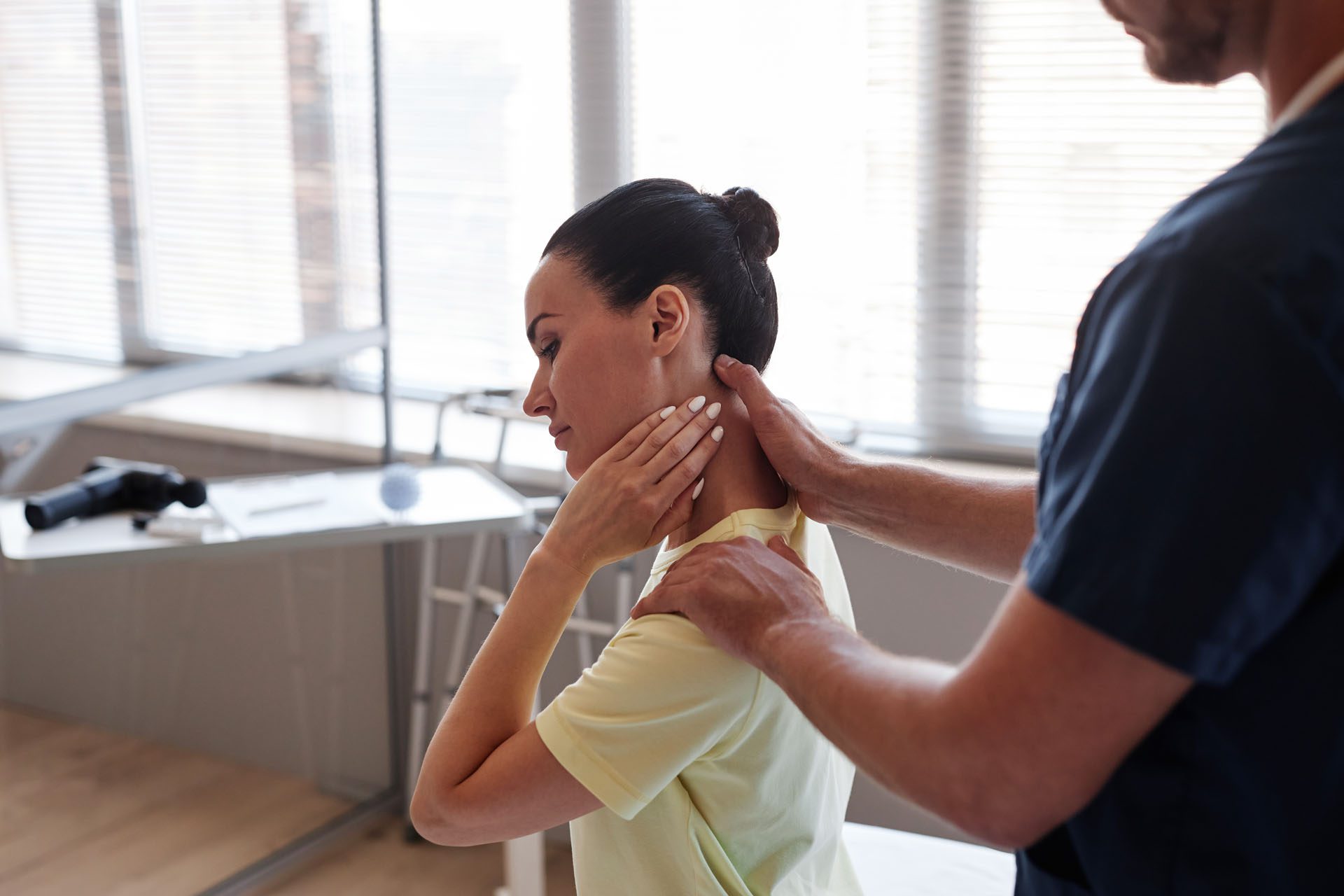Pinched Nerve in the Neck: Managing Your Pain
Can physical therapy help individuals with a pinched nerve in the neck?

Pinched Nerve In The Neck
A pinched nerve in the neck can cause pain, numbness, and weakness that extends through the neck, shoulder, and arm. (American Academy of Orthopaedic Surgeons, 2024) Over-the-counter pain medications, resting the muscles, and gentle stretching can help. However, if you’re still in pain after a few days, see a healthcare provider. Common treatments include:
- Rest
- Over-the-counter (OTC) pain meds
- Physical therapy
- Steroid injections
- Wearing a neck collar
Surgery is rarely needed, but it can provide relief if other treatments don’t help. Most of the time, a pinched nerve resolves within days or weeks.
How a Pinched Nerve in the Neck Feels
The term for neck nerve pain is cervical radiculopathy (cervical spine pain). Common symptoms of a pinched nerve in the neck are: (American Academy of Orthopaedic Surgeons, 2024)
- Sharp pain that extends into the shoulder and arm.
- The pain worsens, or there is a shooting sensation when turning the head.
- Tingling or feeling of pins-and-needles in the fingers or hand.
- Weakness in the arm, shoulder, or hand.
- Numbness or loss of feeling.
Often, these symptoms occur only on one side. Some find their pain less when they lift their hand onto their head, which can relieve pressure on the nerve.
Causes
The cervical spine is the spinal cord area around the neck. It’s made up of seven vertebrae. Nerves branch off the spinal cords in the spaces between the vertebrae. Nerve compression occurs when the space between two vertebrae is reduced, putting pressure on the nerve, pinching it, and causing pain. Pinched nerves develop from age because the spinal discs between the vertebrae become compressed over time. Age causes about 70% to 80% of nerve compression. Other factors that cause pinched nerves include: (Harvard Health Publishing, 2021)
- Degenerative disc disease
- A herniated disc
- Injuries like car accidents falls, or other trauma to the spine
- Spinal stenosis
Self-Care Relief
If you have nerve pain and think it is a pinched nerve, self-care can help (National Institute of Neurological Disorders and Stroke, 2025)
Rest
- Find a comfortable position and try to allow the muscles in your neck to relax and rest.
Heat or Ice
- Warmth and coolness can relieve pain and inflammation.
- Use a warm or cool compress for 15 minutes at a time.
Over-The-Counter Pain Medications
- Pain medications, including nonsteroidal anti-inflammatory drugs (NSAIDs), can help bring relief.
Treatment for Severe Symptoms
If pain doesn’t resolve within a few days, or if it is so bad that you can’t go about daily activities, it’s recommended to see a healthcare provider. They can diagnose a pinched nerve after a physical exam and may also recommend imaging, including an X-ray, CT scan, MRI, or EMG, to reveal what’s causing the symptoms. After diagnosing the condition, the healthcare provider will develop a personalized treatment plan, which may include the following (Harvard Health Publishing, 2021)
Physical Therapy
- Physical therapy can help build strength and flexibility in the neck.
- This is especially important if there is frequent nerve pain in the same spot.
Cervical Collar
- A soft cervical collar is a brace that fits around the neck.
- It supports your head so the neck muscles can relax, facilitating healing.
- The collar can also keep the head from turning in painful ways.
Oral Corticosteroids
- Oral steroids like prednisone can help reduce inflammation.
- If inflammation or swelling in the neck puts more pressure on the nerve, they can help.
Steroid Injections
- Steroid shots right into the painful tissue reduce inflammation right away.
Muscle Relaxers
- These medications keep the muscles in the neck from seizing up.
- As the muscles relax, this brings pain relief.
Narcotic Pain Medications
- Narcotic pain medications can be used short-term by individuals who have severe pain.
- A healthcare provider will inform the patient of the benefits and drawbacks of these medications, which include opiates.
Neck Exercises
Gentle stretches can help alleviate the pain and strengthen the muscles. (National Health Service, 2025)
Chin to chest
- Bring your chin toward your chest.
- Hold for 20 seconds, then return to a neutral position.
- Do this five times.
Eyes to Sky
- Lean your head back and look toward the sky.
- Hold for 20 seconds, then return to your starting position.
- Do this five times.
Side to Side
- Turn your head to the right as far as possible, bringing your chin in line with your shoulder.
- Hold for 20 seconds, then turn as far as possible toward the left.
- Repeat four times.
Ear to Shoulder
- Bring your ear down toward your shoulder.
- Hold for 20 seconds, then repeat the exercise on the other side.
- Alternate between the right and left, stretching each side five times.
While it’s normal for exercises to hurt from stretching the muscles, they should never hurt more than a five on a pain scale of 1 to 10. If they do, stop exercising (National Health Service, 2025)
Healing Time
Healing and recovery depend on the severity of the injury. Some individuals find that the pain from a pinched nerve goes away in days, while for others, it can last for weeks. The pain goes away and then returns. If pain doesn’t go away with the conservative treatments or lasts more than a few days, talk with a healthcare provider or return for a second visit. Rarely do individuals need surgery to bring pain relief. The healthcare provider will discuss whether surgery is the best option and what to expect regarding pain relief. (American Academy of Orthopaedic Surgeons, 2024)
Injury Medical Chiropractic and Functional Medicine Clinic
Injury Medical Chiropractic and Functional Medicine Clinic works with primary healthcare providers and specialists to build optimal health and wellness solutions. We focus on what works for you to relieve pain, restore function, prevent injury, and mitigate issues through adjustments that help the body realign itself. The clinic can also work with other medical professionals to integrate a treatment plan to resolve musculoskeletal problems.
Revitalize and Rebuild with Chiropractic
References
American Academy of Orthopaedic Surgeons. OrthoInfo. (2024). Cervical radiculopathy (pinched nerve). https://orthoinfo.aaos.org/en/diseases–conditions/cervical-radiculopathy-pinched-nerve/
Harvard Health Publishing. Publishing, H. H. (2021). Treating a pinched nerve. https://www.health.harvard.edu/pain/treating-a-pinched-nerve
National Institute of Neurological Disorders and Stroke. (2025). Pinched Nerve Definition. Retrieved from https://www.ninds.nih.gov/health-information/disorders/glossary-neurological-terms#-P-
National Health Service. Service, N. H. (2025). Exercises for neck problems. https://www.nhsinform.scot/illnesses-and-conditions/muscle-bone-and-joints/neck-and-back-problems-and-conditions/exercises-for-neck-problems

